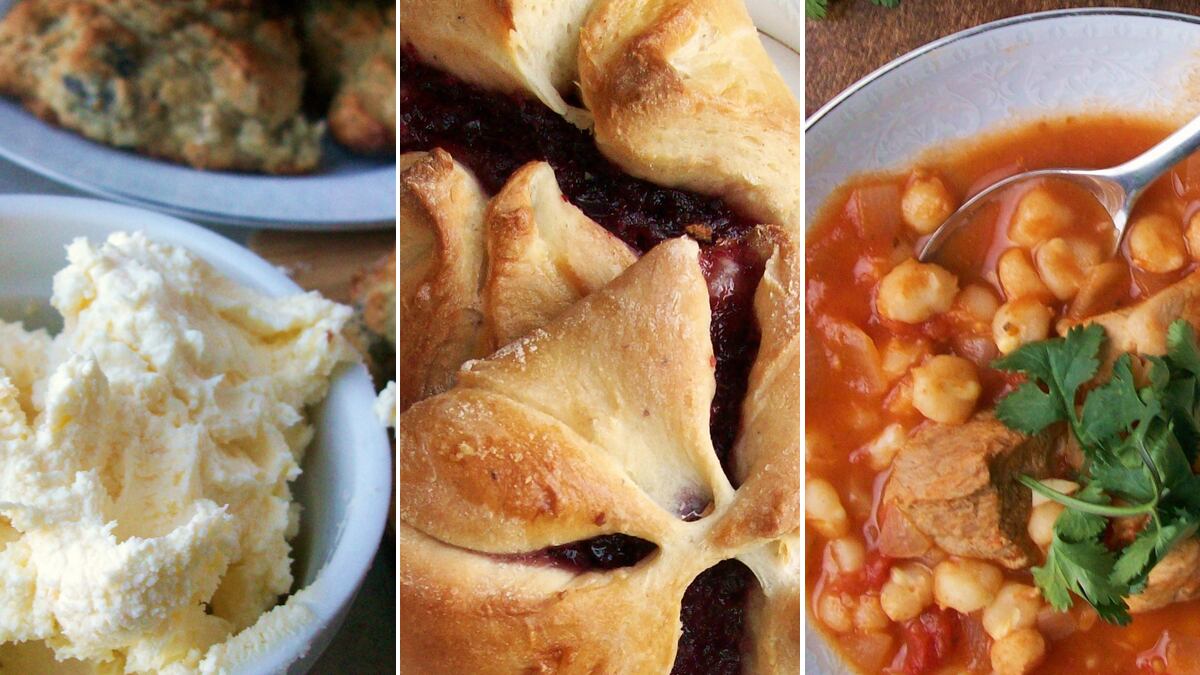Somehow authors can always be counted on to work up tremendous appetites. What dish did John Steinbeck cook on his day off, and what was Agatha Christie’s favorite midnight snack?
Although Hemingway wrote some mouth-watering passages in A Moveable Feast, his appreciation for food wasn’t confined to the page. As evidenced in The Hemingway Cookbook, it seeped out in every part of his life, from cooking trout over a campfire in Michigan to mixing Papa Doubles on the beach in Cuba.
These 10 authors had similar epicurean tendencies, which nourished their writing—and often spilled into it.
George Orwell—Plum Pudding

His food writing isn’t as well known as his novels or political essays, but George Orwell was full of opinions about cooking, and wasn’t shy about expressing them. In the unpublished 1946 essay “British Cookery,” he took the cuisine of his home country to task, and the results aren’t pretty. British food, Orwell said, was “simple, rather heavy, perhaps slightly barbarous.” Seafood “is seldom well cooked” and milk puddings are “the kind of thing that one would prefer to pass over in silence.”
But Orwell did think the British made one thing particularly well: plum pudding. A traditional Christmas dessert, Orwell called it “one of the greatest glories of British cookery … an extremely rich, elaborate and expensive dish.” Deceptively, plum pudding contains no plums. Instead, think dried fruits, nuts, and spices—a holiday fruitcake you might actually want to eat.
Recipe: Plum Pudding
Agatha Christie—Devonshire Cream

Miss Marple famously delighted in clotted cream, but her appetite pales in comparison to that of her creator. Agatha Christie was so partial to cream that she regularly kept some by her typewriter, to sip while she wrote. As her grandson Mathew remembered, “She used to drink cream from a huge cup with ‘Don’t be greedy’ written on the side.” Apparently, it was a warning that went unheeded.
Christie grew up in Devon county, where clotted cream was served as a traditional accompaniment to scones during teatime (hence the name Devonshire cream). But often Christie found the scone superfluous, and just ate the cream by the spoonful instead. “So much nicer than cod liver oil, my mother used to say,” she wrote.
Recipe: Devonshire Cream
Jack Kerouac—Apple Pie

“I ate another apple pie and ice cream; that’s practically all I ate all the way across the country, I knew it was nutritious and delicious, of course.” That’s Sal in On the Road, but it could have been Jack Kerouac himself. In 1947, Kerouac bought a bus ticket from New York to Chicago, the first leg in his journey West that would serve as the basis for his best-known work.
Another author whose characters’ food habits mirrored his own, Kerouac wrote to his mother from the road, in a letter than sounds suspiciously similar to Sal’s menu: “I’ve been eating apple pie & ice cream all over Iowa & Nebraska, where the food is so good.” It was also one of the cheapest offerings at diners around the country—another major point in its favor.
Recipe: Apple Pie
J.D. Salinger—Roast Beef

Even legendary recluses have to eat, and roast beef was the thing that got J. D. Salinger out of the house. Every Saturday, he would make the drive from his home in Cornish, N.H. to the famous Saturday suppers at the First Congregational Church in Hartland, Vt. Regulars recall Salinger arriving early—eager to get in the first seating—and passing the time by silently writing in his notebook.
When the meal was served, Salinger helped himself to the all-you-can-eat spread of roast beef, mashed potatoes, and pie. And although his declining health eventually kept him from making the trip to Hartland, it didn’t stop him from eating roast beef: his wife, Colleen O’Neill, came every week to load up a plate to go.
Recipe: Roast Beef
Jean-Paul Sartre—Halva

It’s hard to imagine Jean-Paul Sartre sitting down for a snack, but his letters to Simone De Beauvoir reveal his sweet tooth, and especially his love of halva. After being drafted into the army during World War II, Sartre asks for several boxes of the nut- and honey-based confection—then panics when it doesn’t arrive. “I got your books but no halva. Is there another package?”
Sartre eventually got his halva, which came wrapped in individual bars and sprinkled with chopped almonds. He didn’t contain his excitement: “We ate the whole box at lunch,” he admitted.
Recipe: Halva with Almonds
Truman Capote—Italian Summer Pudding

Truman Capote was himself a capable cook, learning to bake and broil after settling down in Sicily with his partner, Jack Dunphy. He was particularly fond of desserts, whipping up cookies and cakes to satisfy his sugar cravings.
But when Capote was introduced to summer pudding, while having lunch with the Queen Mother in 1962, his eyes lit up; his friend Cecil Beaton remembers him shouting with joy. It was “the best cake I’ve ever tasted,” Capote wrote. “A sort of chocolate cream stuffed with fresh raspberries.” Italian summer puddings, with layers of berries, ladyfingers, and chocolate mascarpone, recall a lighter version of tiramisu. Plus, there’s booze involved—another of Capote’s vices.
Recipe: Italian Summer Pudding
Walt Whitman—Coffee Cake

While many authors favored liquor and sweets, Walt Whitman knew the value of a good breakfast. In his daybooks, the only two recipes he noted down were both for the morning meal: doughnuts and coffee cake. That’s not to say he limited his coffee cake intake after noon. As he wrote in a letter, “I was foolish enough to take a good strong drink, & eat a couple of slices of rich cake late at night.” Even Whitman was not immune to the allure of the midnight snack.
Coffee cakes in Whitman’s day were not the sugary, streusel-like treats we’re familiar with now. Instead, they more closely resembled a dense spice cake, with coffee added right into the batter itself.
Recipe: Coffee Cake
Sylvia Plath—Tomato-Soup Cake

“How I love to cook!” Sylvia Plath wrote in her journals, and going by the meticulous recipe records she kept, she hardly ever stopped. After leaving the U.S. for England, Plath asked her mother to send a copy of The Joy of Cooking overseas, which she writes of studying intently, “reading it like a rare novel.”
Baking was Plath’s specialty and she regularly made cakes from The Joy of Cooking while writing: lemon-pudding cake, apple cake, devil’s food cake, banana cake. But one of the most unusual was tomato-soup cake, a mixture of savory and sweet that was one of Plath’s signature dishes.
Recipe: Tomato-Soup Cake
Willa Cather—Kolaches

Willa Cather drew much of her cooking inspiration from her childhood in Red Cloud, Neb., where her family moved when she was 9. Red Cloud had a large Czech and German population, and Cather became particularly interested in her neighbor Annie Pavelka, a Bohemian immigrant who would serve as the inspiration for My Ántonia.
Annie was active in the kitchen, passing down her recipes to future generations of Pavelkas as well as to Cather, who continued to visit even after she left Nebraska for New York. Like Ántonia, Annie baked kolaches, the yeasted pastries that were a staple of Czech households and are still found in various forms in Nebraska and parts of Texas. Although kolaches can be either sweet or savory, Cather preferred sweet: In My Ántonia, they’re filled with spiced plums.
Recipe: Spiced Plum Kolaches
John Steinbeck—Posole

When it came to food, John Steinbeck took his cues from his surroundings, in true locavore style. When living on Long Island, he took advantage of the abundant seafood, regularly fishing and clamming for his supper. While on an extended stay in England, he foraged on the property for greens he could add to a salad, or braise with bacon bits.
But often Steinbeck was traveling across the western U.S., with no good fishing or foraging to be had. So he made posole, according to a simple recipe from his friend, the screenwriter Jack Wagner: just “a can of chili and a can of hominy.” Combine, heat, and serve for a soup that’s ideal for a writer on the road.
Recipe: Pork Posole






